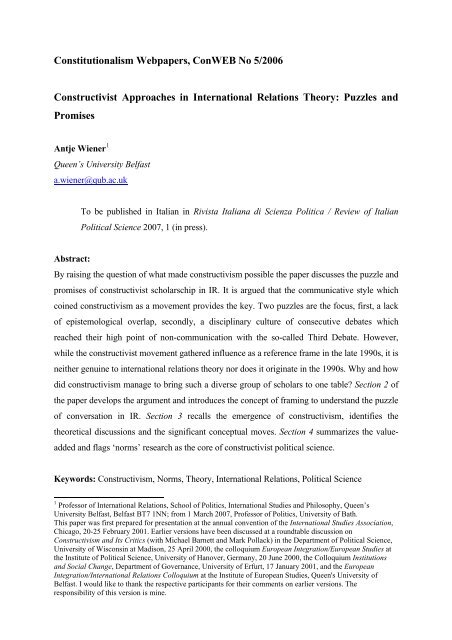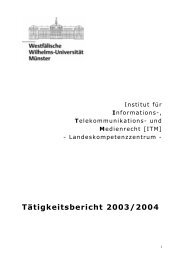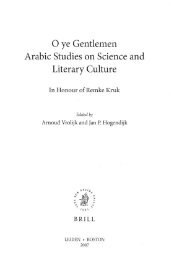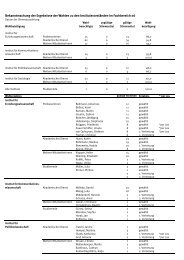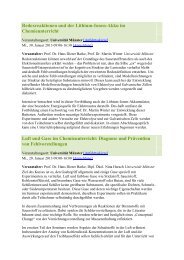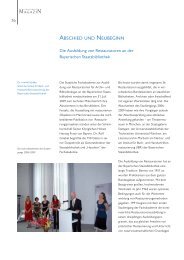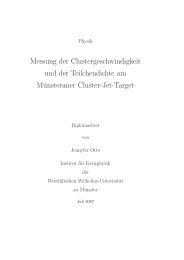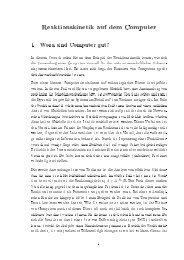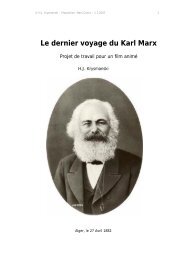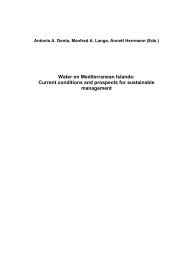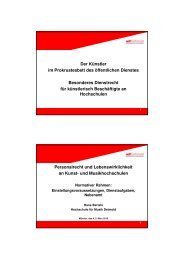Constructivist Approaches in International Relations Theory
Constructivist Approaches in International Relations Theory
Constructivist Approaches in International Relations Theory
You also want an ePaper? Increase the reach of your titles
YUMPU automatically turns print PDFs into web optimized ePapers that Google loves.
Constitutionalism Webpapers, ConWEB No 5/2006<br />
<strong>Constructivist</strong> <strong>Approaches</strong> <strong>in</strong> <strong>International</strong> <strong>Relations</strong> <strong>Theory</strong>: Puzzles and<br />
Promises<br />
Antje Wiener 1<br />
Queen’s University Belfast<br />
a.wiener@qub.ac.uk<br />
Abstract:<br />
To be published <strong>in</strong> Italian <strong>in</strong> Rivista Italiana di Scienza Politica / Review of Italian<br />
Political Science 2007, 1 (<strong>in</strong> press).<br />
By rais<strong>in</strong>g the question of what made constructivism possible the paper discusses the puzzle and<br />
promises of constructivist scholarschip <strong>in</strong> IR. It is argued that the communicative style which<br />
co<strong>in</strong>ed constructivism as a movement provides the key. Two puzzles are the focus, first, a lack<br />
of epistemological overlap, secondly, a discipl<strong>in</strong>ary culture of consecutive debates which<br />
reached their high po<strong>in</strong>t of non-communication with the so-called Third Debate. However,<br />
while the constructivist movement gathered <strong>in</strong>fluence as a reference frame <strong>in</strong> the late 1990s, it is<br />
neither genu<strong>in</strong>e to <strong>in</strong>ternational relations theory nor does it orig<strong>in</strong>ate <strong>in</strong> the 1990s. Why and how<br />
did constructivism manage to br<strong>in</strong>g such a diverse group of scholars to one table? Section 2 of<br />
the paper develops the argument and <strong>in</strong>troduces the concept of fram<strong>in</strong>g to understand the puzzle<br />
of conversation <strong>in</strong> IR. Section 3 recalls the emergence of constructivism, identifies the<br />
theoretical discussions and the significant conceptual moves. Section 4 summarizes the valueadded<br />
and flags ‘norms’ research as the core of constructivist political science.<br />
Keywords: Constructivism, Norms, <strong>Theory</strong>, <strong>International</strong> <strong>Relations</strong>, Political Science<br />
1 Professor of <strong>International</strong> <strong>Relations</strong>, School of Politics, <strong>International</strong> Studies and Philosophy, Queen’s<br />
University Belfast, Belfast BT7 1NN; from 1 March 2007, Professor of Politics, University of Bath.<br />
This paper was first prepared for presentation at the annual convention of the <strong>International</strong> Studies Association,<br />
Chicago, 20-25 February 2001. Earlier versions have been discussed at a roundtable discussion on<br />
Constructivism and Its Critics (with Michael Barnett and Mark Pollack) <strong>in</strong> the Department of Political Science,<br />
University of Wiscons<strong>in</strong> at Madison, 25 April 2000, the colloquium European Integration/European Studies at<br />
the Institute of Political Science, University of Hanover, Germany, 20 June 2000, the Colloquium Institutions<br />
and Social Change, Department of Governance, University of Erfurt, 17 January 2001, and the European<br />
Integration/<strong>International</strong> <strong>Relations</strong> Colloquium at the Institute of European Studies, Queen's University of<br />
Belfast. I would like to thank the respective participants for their comments on earlier versions. The<br />
responsibility of this version is m<strong>in</strong>e.
ConWEB No. 5/2006 Antje Wiener<br />
1 Introduction: Communication Out of a Paradigmatic Battle Field<br />
The academic context of <strong>International</strong> <strong>Relations</strong> theory (IR) is usually framed as a history of<br />
consecutive debates, beg<strong>in</strong>n<strong>in</strong>g with the first debate between idealists and realists, proceed<strong>in</strong>g<br />
with the second debate between historicists and scienticists and reach<strong>in</strong>g a high po<strong>in</strong>t of<br />
controversy with the <strong>in</strong>famous “Third Debate” between positivists and post-positivists. 2 It has<br />
been observed that it was the fourth debate, namely the exchange between rationalist and<br />
constructivists (see Table 1), which resembled an actual conversation among different<br />
theoretical positions <strong>in</strong> the discipl<strong>in</strong>e for the very first time. What had been perceived as debates<br />
had, <strong>in</strong> fact, little <strong>in</strong> common with the practice of discursive <strong>in</strong>teraction or even deliberation<br />
with a view to be persuaded by the better argument of the conversation partner at any time<br />
throughout the first debates. In short, when paradigmatic competition was the issue, the<br />
discipl<strong>in</strong>e appeared more like an academic battlefield where participants took no prisoners.<br />
Table 1: Fram<strong>in</strong>g Debates<br />
Time<br />
Frames<br />
Paradigms Idealism vs.<br />
Realism<br />
1920s -<br />
1930s<br />
1950s - 1960s 1980s 1990s<br />
First Debate Second Debate Third Debate Fourth Debate<br />
Scientific<br />
Behaviourism<br />
vs.<br />
Traditionalism<br />
Post-Positivists vs.<br />
Positivists<br />
<strong>Constructivist</strong>s vs.<br />
Rationalists vs.<br />
Reflectivists<br />
Communication unilateral bilateral bilateral Multilateral<br />
Focus Institutions<br />
vs. Interests<br />
Innovation State system<br />
vs. Society of<br />
states<br />
Science vs.<br />
History<br />
Behavioural<br />
explanation<br />
Epistemology:<br />
Positivism vs.<br />
Postpositivism/Critical<br />
<strong>Theory</strong><br />
Explanation vs.<br />
Understand<strong>in</strong>g<br />
Ontology:<br />
social vs.<br />
material capabilities<br />
Causal vs.<br />
Constitutive<br />
Explanation and/or<br />
Understand<strong>in</strong>g<br />
What is surpris<strong>in</strong>g is that the fourth debate could emerge from its battle-ridden discipl<strong>in</strong>ary<br />
context, which was best known to students of the 1990s as a sequence of “<strong>in</strong>terparadigm<br />
battles” (Lapid 1989). After all, third debaters kept with the practice of b<strong>in</strong>ary position<strong>in</strong>g as the<br />
dom<strong>in</strong>ant discipl<strong>in</strong>ary practice <strong>in</strong> the 1980s. This style reflected the either/or-logic of cold war<br />
politics, and the central structur<strong>in</strong>g element of modern philosophy, which has been long<br />
2<br />
See most explicitly Waever's observation of a 'state of war' (1997, 22), see also Lapid (1989), Whitworth<br />
(1989).<br />
- 2 -
ConWEB No. 5/2006 Antje Wiener<br />
criticised by fem<strong>in</strong>ist scholarship. 3 In the 1990s, however, constructivism was able to break<br />
with the traditional battlefield behaviour. Indeed, constructivism turned <strong>in</strong>to a buzzword <strong>in</strong><br />
<strong>in</strong>ternational relations and European <strong>in</strong>tegration theoris<strong>in</strong>g, so much so, that the notion of a<br />
“constructivist turn” (Checkel 1998) became widely accepted <strong>in</strong> the community. <strong>Constructivist</strong>s<br />
were found to be “seiz<strong>in</strong>g the middle ground” (Adler 1997) and aspired to construct a<br />
compromise based on a “via media through the Third Debate” (Wendt 1999, 39-40). In short,<br />
the constructivist move contributed to “establish<strong>in</strong>g the middle-ground” (Christiansen et al.<br />
1999, 535-537, 542-544) between the mutually exclusive paradigmatic positions of the solabelled<br />
rationalists and reflectivists, by tak<strong>in</strong>g a third position above a base-l<strong>in</strong>e of a b<strong>in</strong>ary<br />
relationship between positivism and postmodernism allowed for a web of communications to<br />
emerge (see Figure 1).<br />
Figure 1: Core Theoretical Positions<br />
Constructivism<br />
‘Rationalism’ ‘Reflectivism’<br />
Source: Christiansen, Jørgensen and Wiener, 1999: 532 4<br />
The metatheoretical move of tak<strong>in</strong>g a third position while focus<strong>in</strong>g on middle-range theoris<strong>in</strong>g,<br />
i.e. discuss<strong>in</strong>g the ontologies (identity, norms, ideas, discursive practices) created an open<strong>in</strong>g<br />
for ‘friendly’ debates (Risse and Wiener 1999) which moved IR theory forward from the gridlock<br />
of b<strong>in</strong>ary position<strong>in</strong>g. In the wake of this move, the popularity of constructivism as a label<br />
for a strong movement <strong>in</strong> <strong>in</strong>ternational relations theory and theories of European <strong>in</strong>tegration still<br />
3 See e.g. List and Studer (1989) the work of Judith Butler, Susan Hekman, Carol Pateman and many others, as<br />
well as <strong>in</strong> IR for example the work of Sandra Whitworth, Spike Peterson and Cyntha Weber, respectively.<br />
4 Note that this figure’s basel<strong>in</strong>e displays the b<strong>in</strong>ary approach to IR theoris<strong>in</strong>g as it has been constructed by<br />
rationalists. The opposition between ‘rationalists’ and ‘reflectivists’ was a construction of Robert Keohane<br />
(1988).<br />
- 3 -
ConWEB No. 5/2006 Antje Wiener<br />
stands strong two decades after the first constructivist moves <strong>in</strong> the 1980s. 5 In the process,<br />
empirical research has produced detailed and comparative case studies, for example, on the<br />
impact of norms such as human rights, m<strong>in</strong>ority rights, citizenship rights or environmental<br />
standards; on chang<strong>in</strong>g strategic positions <strong>in</strong> global politics and games <strong>in</strong>ternational actors play:<br />
on the role of socialisation <strong>in</strong> <strong>in</strong>ternational organisations; on the diffusion of specific<br />
adm<strong>in</strong>istrative cultures; and on the <strong>in</strong>fluence of different rationales on compliance with global<br />
norms, pr<strong>in</strong>ciples and procedures identified by <strong>in</strong>ternational law.<br />
Two Puzzles<br />
In recall<strong>in</strong>g the movement’s emergence, substance and the challenges ly<strong>in</strong>g ahead, this article<br />
raises the question of what made the constructivist movement possible. In the follow<strong>in</strong>g, I argue<br />
that much of its popularity is due to the communicative style, which co<strong>in</strong>ed constructivism as a<br />
movement. Does it, however, offer potential beyond its capacity to raise stimulat<strong>in</strong>g research<br />
questions? Why did <strong>in</strong>terest <strong>in</strong> constructivism <strong>in</strong>crease <strong>in</strong> the 1990s and how was it possible for<br />
constructivism to br<strong>in</strong>g together scholars from such a broad range of <strong>in</strong>tellectual backgrounds?<br />
The use of constructivist language by a set of scholars from backgrounds or bases as diverse as<br />
neofunctionalism, the English School, the Frankfurt School, the Copenhagen School or the<br />
Stanford School is puzzl<strong>in</strong>g on two grounds (Moravcsik 1999, Haas 2001, Dunne 1995, Risse<br />
2000, F<strong>in</strong>nemore 1996, Long 1995). First, the research tools and conceptual assumptions of the<br />
scholars affiliated with the various approaches differ to the po<strong>in</strong>t of be<strong>in</strong>g mutually exclusive.<br />
Secondly, the discipl<strong>in</strong>e of <strong>in</strong>ternational relations has been characterised by a culture of<br />
consecutive debates, which reached their high po<strong>in</strong>t of non-communication, dis<strong>in</strong>terest and<br />
misunderstand<strong>in</strong>g with the third debate. Why and how did constructivism, then, manage to<br />
br<strong>in</strong>g these scholars to sit at one table? 6 To answer this question, I exam<strong>in</strong>e constructivism as a<br />
movement <strong>in</strong> the subdiscipl<strong>in</strong>e of <strong>in</strong>ternational relations. This movement gathered <strong>in</strong>fluence as a<br />
shared frame of reference <strong>in</strong> the late 1990s (Checkel 1998), yet it is neither genu<strong>in</strong>e to<br />
<strong>in</strong>ternational relations theory nor does it orig<strong>in</strong>ate <strong>in</strong> the 1990s. 7<br />
To understand how the movements’ emergence from with<strong>in</strong> the context of <strong>in</strong>ternational<br />
5<br />
Note that while appreciat<strong>in</strong>g Onuf’s ‘World of our Mak<strong>in</strong>g’ (1989) as one of the found<strong>in</strong>g constructivist works<br />
<strong>in</strong> IR, this article emphasises the role Kratochwil’s (1984, 1989, Kratochwil and Ruggie 1986) and Wendt’s early<br />
work (1987) especially the proposition to <strong>in</strong>corporate the Giddensian approach to ‘structuration’ <strong>in</strong>to IR theory<br />
as a key step <strong>in</strong>to the constructivist direction, played <strong>in</strong> mov<strong>in</strong>g away from the polarity of the Third Debate.<br />
6<br />
See Gabriel Almond's argument for the opposite move, for example, to describe the situation <strong>in</strong> political<br />
science <strong>in</strong> the 1980s (Almond 1996).<br />
7<br />
See for example the works of Simmel, Luhmann, Luckman and Berger and others.<br />
- 4 -
ConWEB No. 5/2006 Antje Wiener<br />
relations theory was possible, I recall the theoretical questions raised by two major<br />
constructivist moves – one epistemological the other ontological – and identify the contents of<br />
the emerg<strong>in</strong>g tool-kit. The article proceeds <strong>in</strong> three further sections. Section 2 develops the<br />
argument and <strong>in</strong>troduces the concept of fram<strong>in</strong>g from proposed by the resource mobilisation<br />
approach <strong>in</strong> social movement theories to understand the puzzle of conversation <strong>in</strong> IR. Section 3<br />
recalls the emergence of constructivism with the debat<strong>in</strong>g culture, identifies the theoretical<br />
discussions which established constructivism as a frame facilitat<strong>in</strong>g communication and the<br />
significant conceptual moves which allowed for the <strong>in</strong>clusion of ‘the social’ <strong>in</strong>to political<br />
science. Section 4 summarizes the value-added and flags ‘norms’ research as the core of<br />
constructivist political science and the sign-post concept of its limited bridge-build<strong>in</strong>g<br />
capacities.<br />
2 Interaction on the Middle Ground<br />
<strong>Constructivist</strong>s focus on middle-range theoriz<strong>in</strong>g and <strong>in</strong>clude the role of social factors <strong>in</strong> world<br />
politics. They usually produce more agreement with regard to ontological issues such as the<br />
general assumption of the social construction of th<strong>in</strong>gs than with regard to the epistemological<br />
basis of the respective research question which needs to be asked (Fierke 2006).<br />
Constructivism's quality of facilitat<strong>in</strong>g theoretically <strong>in</strong>formed deliberation among scholars has<br />
been characterized as “an attempt [...] to build a bridge between the widely separated<br />
positivist/materialist and idealist/<strong>in</strong>terpretive philosophies of social science”. (Adler 1997, 323;<br />
Checkel 2000; emphasis added AW) It has led to enhanced theoriz<strong>in</strong>g of the middle ground<br />
even though bridge build<strong>in</strong>g is not generally welcomed. 8 Despite reservations expressed<br />
towards the concept of ‘friendly debates’ and the call to evoke the tradition of ‘fault-l<strong>in</strong>e<br />
politics’ <strong>in</strong> IR <strong>in</strong>stead, 9 the recurr<strong>in</strong>g reference to bridge build<strong>in</strong>g has been a marker of the<br />
movement (Zuern and Checkel 2005). It has become a key property of constructivism; yet, it<br />
may also turn <strong>in</strong>to the prime obstacle to reach<strong>in</strong>g new theoretical high ground. The primary<br />
<strong>in</strong>terest of the follow<strong>in</strong>g sections lies <strong>in</strong> explor<strong>in</strong>g the role of constructivism as a movement<br />
with<strong>in</strong> a particular context and as voic<strong>in</strong>g a particular message. The focus is therefore on<br />
8 This is most explicitly expressed by Risse (2000) who summarises extensive debates among rationalist and<br />
constructivist <strong>in</strong>stitutionalist discussions <strong>in</strong> the German Journal of <strong>International</strong> <strong>Relations</strong>.<br />
9 A number of scholars have suggested, for example, a classification of constructivist approaches accord<strong>in</strong>g to<br />
their subscription to positivist assumptions, identify<strong>in</strong>g them as 'modern' constructivists and, <strong>in</strong> the process<br />
evok<strong>in</strong>g the camp mentality of the arguable helpful debat<strong>in</strong>g culture <strong>in</strong> <strong>in</strong>ternational relations theories (IR), see<br />
e.g. Katzenste<strong>in</strong>, Keohane and Krasner 1998; Waever 1997, 24; Smith 1999, and the critical response to Smith<br />
1999 and Moravcsik 1999 by Risse and Wiener 1999.<br />
- 5 -
ConWEB No. 5/2006 Antje Wiener<br />
<strong>in</strong>teraction among constructivists, reflect<strong>in</strong>g reference to theoretical and discipl<strong>in</strong>ary parameters<br />
(i.e. experience; how situated with<strong>in</strong> the discipl<strong>in</strong>ary debates?) and formulat<strong>in</strong>g new analytical<br />
categories (what is the result of shared constructivist debates?).<br />
How was it possible, then, for constructivism to have such an <strong>in</strong>fluential <strong>in</strong>put on the debate <strong>in</strong><br />
the discipl<strong>in</strong>e that two decades later, realists seek to be <strong>in</strong>cluded <strong>in</strong> conversations with<br />
constructivsts? 10 For an answer to this query, this article will apply the constructivist<br />
methodology of constitutive explanation (Wendt 1998). I proceed <strong>in</strong> two steps. The first step<br />
identifies the constitutive aspects of this development. The second step seeks to expla<strong>in</strong> why<br />
constructivism, and not, for example, reflectivism (as <strong>in</strong> the Third Debate) became so vital to<br />
the fourth debate. The explanation is elaborated by draw<strong>in</strong>g on the concept of ‘frames’, which<br />
provides actors with a codified reference to a set of complex issues (Snow and Benford 1992).<br />
This concept has been applied <strong>in</strong> particular <strong>in</strong> social movement theories to expla<strong>in</strong> the cyclic<br />
emergence of protest movements. In conclud<strong>in</strong>g, the article highlights the importance of two<br />
constructivist assumptions <strong>in</strong> further develop<strong>in</strong>g the mosaic of constructivist theoris<strong>in</strong>g. These<br />
<strong>in</strong>clude first, the importance of ideas as social capabilities which matter <strong>in</strong> addition to material<br />
capabilities; and secondly, the assumption of the dual quality of norms as both structur<strong>in</strong>g and<br />
constituted through <strong>in</strong>teraction. These two constructivist assumptions are key to the project of<br />
extend<strong>in</strong>g the communicative movement constructivism had <strong>in</strong>itiated with<strong>in</strong> <strong>in</strong>ternational<br />
relations theory towards conversations across boundaries. Such conversations have begun for<br />
example with <strong>in</strong>ternational lawyers. And a common yet rather contested <strong>in</strong>terface between IR<br />
and <strong>in</strong>ternational law is the constitution of the normative structure <strong>in</strong> world politics based on<br />
discussions about <strong>in</strong>corporat<strong>in</strong>g the good life or, resort<strong>in</strong>g to positivism (Slaughter 2004, Reus-<br />
Smit 2001, Koskenniemi 2002). Here, an extension from the heretofore strong constructivist<br />
focus on organisation theory and language games which studied logics of action<br />
(consequentialism, appropriateness and argu<strong>in</strong>g) towards the <strong>in</strong>corporation of normative<br />
theoris<strong>in</strong>g based on the pr<strong>in</strong>ciples of democratic constitutionalism (Tully 2006) will play a key<br />
role.<br />
Follow<strong>in</strong>g the earlier periods of theoris<strong>in</strong>g which has brought <strong>in</strong> concepts from law, science and<br />
economics dur<strong>in</strong>g the various paradigmatic ‘debates’ <strong>in</strong> an predom<strong>in</strong>antly Anglo-Saxon<br />
<strong>in</strong>ternational relations theory (Dougherty and Pfalzgraff 1996, Waever 1998), more recently,<br />
constructivists have drawn on discipl<strong>in</strong>es such as sociology, psychology, and philosophy. These<br />
- 6 -
ConWEB No. 5/2006 Antje Wiener<br />
moves usually focus on <strong>in</strong>dividuals or groups of people rather than states, <strong>in</strong>ternational<br />
organisations and non-government actors <strong>in</strong> world politics. Subsequently, while leav<strong>in</strong>g<br />
paradigm battles over epistemological issues aside and by focus<strong>in</strong>g on ontology, the analytical<br />
tool-kit of <strong>in</strong>ternational relations theories has been enriched through the <strong>in</strong>corporation of<br />
‘structuration’ (Wendt 1987), ‘norms’ (Kratochwil 1989, Katzenste<strong>in</strong> 1996, F<strong>in</strong>nemore 1996,<br />
Klotz 1996), ‘logics of behaviour’ (March and Olsen 1989, Risse, Ropp and Sikk<strong>in</strong>k 1999),<br />
‘identity’ and ‘fram<strong>in</strong>g’ (Keck and Sikk<strong>in</strong>k 1998), ‘<strong>in</strong>tersubjectivity’ (Kratochwil and Ruggie<br />
1986) and ‘socialisation’ (Risse, Ropp and Sikk<strong>in</strong>k 1999, Johnston 2001, Zuern and Checkel<br />
2005).<br />
The follow<strong>in</strong>g offers a view from the outside <strong>in</strong> to assess the moves constructivists undertook to<br />
get to this po<strong>in</strong>t. The methodological start<strong>in</strong>g po<strong>in</strong>t for this exercise is provided by social<br />
movement theorists and their efforts to expla<strong>in</strong> the ebb and flow of protest mobilization i.e.<br />
“temporal cluster<strong>in</strong>g” and “the cyclicity” of activity (Snow and Benford 1992, 134). Here, a<br />
shared frame is considered to expla<strong>in</strong> the motivation to act. A ‘frame’ is def<strong>in</strong>ed as<br />
“an <strong>in</strong>terpretative schemata (sic) that simplifies and condenses the 'world out there' by<br />
selectively punctuat<strong>in</strong>g and encod<strong>in</strong>g objects, situations, events, experiences, and<br />
sequences of action with<strong>in</strong> one's present or past environment.” (Snow and Benford<br />
1992, 136-37)<br />
These frames help <strong>in</strong>dividuals “to locate, perceive, identify, and label events” (Goffman 1974,<br />
21; c.f. Snow and Benford 1992, 137). Their ma<strong>in</strong> function lies <strong>in</strong> focus<strong>in</strong>g and punctuat<strong>in</strong>g, as<br />
well as <strong>in</strong> the attribution of blame and the articulation of a number of events <strong>in</strong>to a simpler code.<br />
The importance of collective action frames is not necessarily based on changed capabilities such<br />
as new ideas. Instead, the success of fram<strong>in</strong>g is caused by ways of present<strong>in</strong>g issues. That is,<br />
“what gives a collective action frame its novelty is not so much its <strong>in</strong>novative ideational<br />
elements as the manner <strong>in</strong> which activists articulate or tie them together”. (Snow and Benford<br />
1992, 138)<br />
This def<strong>in</strong>ition of a collective action frame suggests that the key of a frame is to communicate a<br />
particular understand<strong>in</strong>g of a particular sett<strong>in</strong>g. With a view to the debat<strong>in</strong>g culture, which was<br />
established s<strong>in</strong>ce the 1920s, the concept of fram<strong>in</strong>g offers an understand<strong>in</strong>g of what the debates,<br />
and accord<strong>in</strong>g to this paper's focus, the constructivist debate <strong>in</strong> particular, mean for the<br />
development of the discipl<strong>in</strong>e. This approach suggests that the specific elements of a debate<br />
10 See e.g. Adrian Hyde-Price’s presentation at the 35 th Anniversary Conference of Millennium: Journal of<br />
- 7 -
ConWEB No. 5/2006 Antje Wiener<br />
matter less when compared to how the debate is presented with<strong>in</strong> the discipl<strong>in</strong>e. Based on this<br />
analysis from the ‘outside’ we can therefore conclude that constructivists are brought together<br />
by a shared <strong>in</strong>terest <strong>in</strong> communication about constructivism. This is not necessarily an<br />
agreement about the specific mean<strong>in</strong>g of constructivism as a Lakatosian research programme,<br />
as a (meta-)theory, or a new method, but it conceptualises the constructivist turn as a move to<br />
provide a frame which proved attractive to IR scholars. Tak<strong>in</strong>g this observation as a start<strong>in</strong>g<br />
po<strong>in</strong>t for expla<strong>in</strong><strong>in</strong>g the ris<strong>in</strong>g <strong>in</strong>terest <strong>in</strong> constructivist approaches, means to ask the question of<br />
how are frames constructed? Do they result from strategic action, structural processes, or, both?<br />
To pursue these questions, the argument turns to the history of the discipl<strong>in</strong>e and the debates<br />
which set the framework for today's discussion about constructivism.<br />
To summarize, I argue that the major grand theory debates and their cumulation <strong>in</strong> the current<br />
most communicative fourth debate which focuses on the value of a social constructivist research<br />
programme – as opposed to reflectivist approaches on the one hand, and rationalist approaches,<br />
on the other – present themselves as a series of movements. These movements have developed<br />
<strong>in</strong> cycles accord<strong>in</strong>g to changes of context, ideas, and <strong>in</strong>terests of the actors, i.e. the social<br />
scientists <strong>in</strong>volved <strong>in</strong> the debate. It is strik<strong>in</strong>g to observe that while the first three debates were<br />
largely led <strong>in</strong> a non-verbal and little <strong>in</strong>teractive manner with the third debate leav<strong>in</strong>g people on<br />
less than speak<strong>in</strong>g terms, barely bother<strong>in</strong>g to read what the other camp produced. The current<br />
fourth debate is, surpris<strong>in</strong>gly and dist<strong>in</strong>ctively, characterized by verbal <strong>in</strong>teraction among<br />
various parties. Different from the previous debates, it was even found to be “stimulat<strong>in</strong>g”<br />
(Peterson and Bomberg 2000, 30). What expla<strong>in</strong>s this shift? The puzzle of friendly<br />
communication with<strong>in</strong> an otherwise rather hostile context of paradigmatic battles can be<br />
expla<strong>in</strong>ed by its role as a master frame <strong>in</strong> the social sciences, and, especially a collective action<br />
frame, which has been conducive towards communication among IR scholars of different<br />
stripes.<br />
3 A New Style of Communication and the Launch of a Movement<br />
The first debate <strong>in</strong> IR was largely constructed from a realist po<strong>in</strong>t of view cast backwards <strong>in</strong><br />
history after the WW II; the second debate <strong>in</strong>cluded more <strong>in</strong>teraction impersonated by lead<strong>in</strong>g<br />
scholars <strong>in</strong> the respective fields of diplomatic history and the social sciences (Waever 1997, 10,<br />
<strong>International</strong> Studies, LSE, 21-22 October 2006.<br />
- 8 -
ConWEB No. 5/2006 Antje Wiener<br />
11 respectively); the third debate ma<strong>in</strong>ly consisted <strong>in</strong> a battle over paradigms which <strong>in</strong>cluded<br />
little <strong>in</strong>teraction but mass participation <strong>in</strong> each camp, f<strong>in</strong>ally settl<strong>in</strong>g at the poles of a l<strong>in</strong>e. By<br />
contrast, the fourth debate has moved away from the <strong>in</strong>communicado situation at the respective<br />
poles and has developed a new <strong>in</strong>teractive style of communication. This fourth debate was<br />
framed <strong>in</strong> a particular way. If it is true that<br />
“(m)aster frames are to movement-specific collective action frames as paradigms are to<br />
f<strong>in</strong>ely tuned theories. [...] master frames can be construed as function<strong>in</strong>g <strong>in</strong> a manner<br />
analogous to l<strong>in</strong>guistic codes <strong>in</strong> that they provide a grammar that punctuates and<br />
syntactically connects patterns of happen<strong>in</strong>gs <strong>in</strong> the world.” (Snow and Benford 1992,<br />
138)<br />
then constructivism may <strong>in</strong>deed offer someth<strong>in</strong>g like a master frame. Over time this movement<br />
has led to the <strong>in</strong>corporation of theoretic bits and pieces from other discipl<strong>in</strong>es follow<strong>in</strong>g a<br />
functionalist logic. Thousands of pages of sociological constructivist writ<strong>in</strong>gs later, one of the<br />
most sem<strong>in</strong>al references of sociological constructivism which has co<strong>in</strong>ed a def<strong>in</strong>ition of norms<br />
underly<strong>in</strong>g core hypotheses of constructivist work. Accord<strong>in</strong>gly, norms are def<strong>in</strong>ed “to describe<br />
collective expectations for the proper behaviour of actors with a given identity” (Katzenste<strong>in</strong><br />
1996, 5). Build<strong>in</strong>g on this <strong>in</strong>sight, the “liberal community hypothesis” now applies norms as<br />
structures, identity as given, and studies conditions of behavioural change that matter to<br />
<strong>in</strong>ternational politics (Schimmelfennig 2003). The import of the concept of ‘socialisation’<br />
def<strong>in</strong>ed as “the process of <strong>in</strong>duct<strong>in</strong>g actors <strong>in</strong>to the norms and rules of a given community”<br />
(Zuern and Checkel 2005, 1046) susta<strong>in</strong>s this assumption about stable structures and adaptable<br />
<strong>in</strong>dividual behaviour.<br />
The constructivist move thus built on theoretical <strong>in</strong>put provided by the third debaters on the one<br />
hand, and the import of analytical tools from the neighbour<strong>in</strong>g discipl<strong>in</strong>es of neo<strong>in</strong>stitutionalism<br />
– especially organisation sociology (Powell and DiMaggio 1991, Thomas et al<br />
1987), on the other. The shared view was “that Neorealism and Neoliberalism are<br />
'undersocialized' <strong>in</strong> the sense that they pay <strong>in</strong>sufficient attention to the ways <strong>in</strong> which the actors<br />
<strong>in</strong> world politics are socially constructed. This common thread has enabled a three-cornered<br />
debate with Neorealists and Neoliberals to emerge.” (Wendt 1999, 3-4). This perspective<br />
facilitated a frame of reference for an <strong>in</strong>creas<strong>in</strong>g amount of work <strong>in</strong> <strong>in</strong>ternational relations<br />
theory and <strong>in</strong> European <strong>in</strong>tegration theory as well. In early days when the debat<strong>in</strong>g culture was<br />
still mov<strong>in</strong>g accord<strong>in</strong>g to the rout<strong>in</strong>ised practices of the paradigmatic battleground,<br />
constructivists were often dist<strong>in</strong>guished from positivists by b<strong>in</strong>ary position<strong>in</strong>g. That is, they<br />
- 9 -
ConWEB No. 5/2006 Antje Wiener<br />
were lumped together with those labelled as the ‘other’ from what was considered as the<br />
‘rationalist’ or ‘positivist’ ma<strong>in</strong>stream. Accord<strong>in</strong>gly, they were assumed to fall under the<br />
“reflectivist” or “post-positivist” label (Keohane 1988). Wendt stresses correctly that <strong>in</strong><br />
“this ‘Third Debate' the field has polarized <strong>in</strong>to two ma<strong>in</strong> camps: (1) a majority who<br />
th<strong>in</strong>k science is an epistemically privileged discourse through which we can ga<strong>in</strong> a<br />
progressively truer understand<strong>in</strong>g of the world, and (2) a large m<strong>in</strong>ority who do not<br />
recognize a privileged epistemic status for science <strong>in</strong> expla<strong>in</strong><strong>in</strong>g the world out there. The<br />
former have become known as ‘positivists’ and the latter as ‘post-positivists’, [...] it<br />
might be better to call them ‘naturalists’ and ‘anti-naturalists,’ or advocates of<br />
‘Explanation’ and ‘Understand<strong>in</strong>g’ respectively. In any case, the two sides are barely on<br />
speak<strong>in</strong>g terms today, and seem to see little po<strong>in</strong>t <strong>in</strong> chang<strong>in</strong>g this situation.” (Wendt<br />
1999, 38-39; emphasis added, AW)<br />
The debat<strong>in</strong>g culture set the context for the constructivist turn and the clout it has come to<br />
develop. The theoretical debates with<strong>in</strong> each camp of the third debate pushed the key<br />
conceptual concern which came to be the launch<strong>in</strong>g argument for constructivists to the fore.<br />
Two moves brought the debaters back to the table on the so-called middle ground.<br />
Move 1: Epistemological Queries<br />
The first move was epistemological. It highlighted the role of <strong>in</strong>tersubjectivity <strong>in</strong> regime<br />
analysis. A key theoretical problem had been identified <strong>in</strong> a sem<strong>in</strong>al article by Kratochwil and<br />
Ruggie as the contradiction between epistemology and ontology that is immanent to regime<br />
theory. 11 They argued that unless the constructed nature of norms was theoretically addressed,<br />
regime analysis would cont<strong>in</strong>uously face the problem of contradictions between (positivist)<br />
epistemology and a social ontology (norms). As they wrote,<br />
“The emphasis on convergent expectations as the constitutive basis of regimes gives<br />
regimes an <strong>in</strong>escapable <strong>in</strong>tersubjective quality. It follows that we know regimes by<br />
their pr<strong>in</strong>cipled and shared understand<strong>in</strong>gs of desirable and acceptable forms of social<br />
behavior. Hence, the ontology of regimes rests upon a strong element of<br />
<strong>in</strong>tersubjectivity. Now, consider the fact that the prevail<strong>in</strong>g epistemological position <strong>in</strong><br />
regime analysis is almost entirely positivistic <strong>in</strong> orientation. Before it does anyth<strong>in</strong>g<br />
else, positivism posits a radical separation of subject and object. It then focuses on the<br />
11 This section draws on Christiansen, Joergensen and Wiener 1999, 533-539, 542-543 as Wiener 2003.<br />
- 10 -
ConWEB No. 5/2006 Antje Wiener<br />
‘objective’ forces that move actors <strong>in</strong> their social <strong>in</strong>teractions. F<strong>in</strong>ally, <strong>in</strong>tersubjective<br />
mean<strong>in</strong>g, where it is considered at all, is <strong>in</strong>ferred from behavior. Here, then, we have<br />
the most debilitat<strong>in</strong>g problem of all: epistemology fundamentally contradicts<br />
ontology!” (Kratochwil and Ruggie 1986, 764; emphasis <strong>in</strong> text)<br />
The problem arose on the basis of a lack<strong>in</strong>g match between the concept of regime as entail<strong>in</strong>g<br />
converg<strong>in</strong>g expectations on pr<strong>in</strong>ciples, norms, rules and decision-mak<strong>in</strong>g procedures <strong>in</strong> a given<br />
area of IR (Krasner 1983, 2), on the one hand, and an epistemological framework that assumed<br />
actors' self-<strong>in</strong>terests as given, on the other. As Kratochwil and Ruggie po<strong>in</strong>ted out, the<br />
perception of shared norms was conditional on an analytical framework that allowed for an<br />
understand<strong>in</strong>g of <strong>in</strong>tersubjectivity. The neo/realist approach was not fit to conceptualize<br />
<strong>in</strong>tersubjectivity and could ergo not adequately assess the role of regimes. They identified the<br />
theoretical challenge thus,<br />
“[I]n many [...] puzzl<strong>in</strong>g <strong>in</strong>stances, actor behavior has failed adequately to convey<br />
<strong>in</strong>tersubjective mean<strong>in</strong>g. And <strong>in</strong>tersubjective mean<strong>in</strong>g, <strong>in</strong> turn, seems to have had<br />
considerable <strong>in</strong>fluence on actor behavior. It is precisely this factor that limits the<br />
practical utility of the otherwise fasc<strong>in</strong>at<strong>in</strong>g <strong>in</strong>sights <strong>in</strong>to the collaborative potential of<br />
rational egoists which are derived from laboratory or game-theoretic situations. To put<br />
the problem <strong>in</strong> its simplest terms: <strong>in</strong> the simulated world, actors cannot communicate<br />
and engage <strong>in</strong> behavior; they are condemned to communicate through behavior. In the<br />
real world, the situation of course differs fundamentally.” (Kratochwil and Ruggie 1986,<br />
764-65; emphases <strong>in</strong> text)<br />
Apart from deny<strong>in</strong>g the problematic situation, two solutions were on offer. One option was to<br />
adopt an <strong>in</strong>tersubjective ontology that would be compatible with a positivist epistemology. The<br />
other was to open epistemology towards more <strong>in</strong>terpretative stra<strong>in</strong>s. At the time, the last option<br />
appeared preferable (Kratochwil and Ruggie 1986, 765-766). However, the constructivist turn<br />
and ensu<strong>in</strong>g debates <strong>in</strong> the 1990s demonstrated that the other options had not been dismissed<br />
altogether. Indeed, the preference to comb<strong>in</strong>e a positivist position with an <strong>in</strong>tersubjective<br />
ontology has become widely shared among constructivists.<br />
Move 2: Ontological Move And Ensu<strong>in</strong>g <strong>Constructivist</strong> Debates<br />
The second move was ontological. It suggested that while the structural power of anarchy was<br />
key to state <strong>in</strong>terests (Waltz 1979), it was not exclusively the result of material capabilities but<br />
- 11 -
ConWEB No. 5/2006 Antje Wiener<br />
depended on state identities which were the result of <strong>in</strong>teraction among states as well (Wendt<br />
1992). This view stressed the relation between social <strong>in</strong>teraction of states and the structure of<br />
world politics. It drew on Giddens' structuration theory (1979, 1984) as a second order or meta-<br />
theoretical approach to IR theoriz<strong>in</strong>g (Wendt 1987, 1991). More recently, others have<br />
contributed to ref<strong>in</strong>e sociological constructivism by elaborat<strong>in</strong>g on the cultural environment and<br />
the role of norms <strong>in</strong> security politics <strong>in</strong> particular (F<strong>in</strong>nemore 1996; Klotz 1995, Katzenste<strong>in</strong> ed.<br />
1996, Jepperson et al. 1996). Subsequently, IR theorists developed different ways of<br />
approach<strong>in</strong>g the impact of norms on <strong>in</strong>ternational relations. It is possible to roughly dist<strong>in</strong>guish<br />
two constructivist positions. The first group of scholars drew on <strong>in</strong>sights from the macrosociological<br />
<strong>in</strong>stitutionalism of the Stanford School around John Meyer and from organisational<br />
sociology (DiMaggio and Powell 1991, March and Olson 1989) thus tak<strong>in</strong>g a dist<strong>in</strong>ctly<br />
sociological constructivist perspective which is now labelled ‘modern’ or ‘conventional’<br />
constructivism (F<strong>in</strong>nemore 1996, 2001, Katzenste<strong>in</strong> ed. 1996, Hopf 1998, Checkel 2005). The<br />
major goal of this program is to take the impact of social factors such as ideas and, more<br />
specifically, norms seriously. This view ma<strong>in</strong>ta<strong>in</strong>s that while symbolic <strong>in</strong>teraction constructs<br />
mean<strong>in</strong>g, it is assumed that social reality does exist beyond the theorists' view. Follow<strong>in</strong>g this<br />
logic, sociological constructivism stresses the importance of empirical work <strong>in</strong> order to<br />
approach the world out there. More recent work takes this perception of norms further, seek<strong>in</strong>g<br />
to assess the process of <strong>in</strong>teraction empirically, for example by study<strong>in</strong>g processes of “argu<strong>in</strong>g”<br />
(Risse 2000, Mueller 2004) or “persuasion” (Checkel 2001).<br />
The second group of scholars consider the world ‘out there’ as constructed <strong>in</strong> itself, thus<br />
employ<strong>in</strong>g a view that seeks to understand the ways <strong>in</strong> which the world is constructed. Tak<strong>in</strong>g<br />
the issue of ‘construction’ as their core, these constructivists work with the Wittgenste<strong>in</strong>ian<br />
focus on the role of language as constructive towards norms and rules, and/or apply the two<br />
basic assumptions of critical theory i.e. reflexivity and the oughtness of societal change. They<br />
have accord<strong>in</strong>gly been labelled “consistent constructivists” (Fierke 2006, Zuern and Checkel<br />
2005) and “critical constructivists” (Hopf 1998, Reus-Smit 2003), respectively. Follow<strong>in</strong>g the<br />
concept of language games, consistent constructivists assume that <strong>in</strong>teraction is not reduced to<br />
‘speechless’ but communicative behavior. Instead, action is conceptualised to <strong>in</strong>clude the<br />
practice of speak<strong>in</strong>g a particular language (Kratochwil 1989, Fierke 1998, Zehfuss 1998). The<br />
assumption is that beyond mere utterances, language constitutes mean<strong>in</strong>g with<strong>in</strong> specific<br />
contexts. If successfully performed, speech acts cause a particular mean<strong>in</strong>g that, <strong>in</strong> turn, leads to<br />
rule-follow<strong>in</strong>g. This version of constructivism seeks to explore the constructive power of<br />
- 12 -
ConWEB No. 5/2006 Antje Wiener<br />
language <strong>in</strong>terrelated with rules that are <strong>in</strong>herent to a specific social context (Hollis and Smith<br />
1990; Onuf 1989; Kratochwil 1989; Fierke 1998; Buzan et al. 1998).<br />
As Reus-Smit stresses, “[C]onstructivism is divided, however, between those who rema<strong>in</strong><br />
cognizant of the critical orig<strong>in</strong>s and potentiality of their sociological explorations, and those<br />
who have embraced constructivism simply as an explanatory or <strong>in</strong>terpretive tool.” (Reus-Smit<br />
2003). Thus, critical constructivists would emphasise the role of <strong>in</strong>tersubjectivity and the<br />
implications of cont<strong>in</strong>gent and contextual <strong>in</strong>teraction for both societal change and the<br />
advancement of theory (Schwellnus 2006, Niessen and Herborth 2007, <strong>in</strong> press). They focus on<br />
theoris<strong>in</strong>g <strong>in</strong>teraction with regard to the normative structure and its <strong>in</strong>stitutionalised pr<strong>in</strong>ciples<br />
and procedures <strong>in</strong> world politics as the core of any debates about fair and democratic<br />
governance <strong>in</strong> beyond-the-state contexts (Koskenniemi 2002). Taken together, however, all<br />
three constructivists strands, i.e. conventional, consistent, and critical constructivists share the<br />
observation of the construction of identity and <strong>in</strong>terest that makes behavior <strong>in</strong> global politics<br />
relational rather than rational. This <strong>in</strong>terface co<strong>in</strong>s the general constructivist theoretical<br />
perspective that challenges both neorealist and neoliberal positions. While it is placed at a<br />
particular shared time given the larger trajectory of IR as a discipl<strong>in</strong>e, the actual theoretical<br />
<strong>in</strong>put of constructivist debates is generated from different places, and <strong>in</strong>deed communities of IR<br />
scholars with their own <strong>in</strong>tellectual path-dependencies. For example, debates <strong>in</strong> the UK,<br />
Scand<strong>in</strong>avia, Germany and Canadian IR have contributed to developments <strong>in</strong> constructivist<br />
th<strong>in</strong>k<strong>in</strong>g. 12<br />
Table 2: Communication and Methodological Focus<br />
(+)<br />
width of Second Debate<br />
communication Bilateral<br />
(-) First Debate<br />
unilateral<br />
(-) shared methodological focus (+)<br />
Fourth Debate<br />
multi-lateral<br />
Third Debate<br />
bilateral<br />
The po<strong>in</strong>t of this brief review is to stress the <strong>in</strong>tersubjective nature of constructivism itself.<br />
12 For a good overview see Waever 1998; for the development, change and perception of <strong>in</strong>tellectual debates on<br />
a global level see Berger and Luckman 1966, 1991.<br />
- 13 -
ConWEB No. 5/2006 Antje Wiener<br />
Theoriz<strong>in</strong>g does not develop out of context. Instead, the respective political culture and the<br />
participants of a debate bear on the way theories, or, for that matter research programs are<br />
shaped, too.<br />
Establish<strong>in</strong>g The Middle Ground<br />
The constructivist move allowed for a focus on the middle ground between ‘rationalist’<br />
(neo/realist) and ‘reflectivist’ (postmodernist, poststructuralist) positions that held diametrically<br />
opposed epistemological assumptions. The move towards a third position <strong>in</strong> distance to both of<br />
the above (see Figure 1) allowed constructivists to develop positions <strong>in</strong> distance to yet <strong>in</strong><br />
conversation with both of these <strong>in</strong>commensurable theoretical standpo<strong>in</strong>ts. This is exemplified<br />
by the fact that most constructivists do, <strong>in</strong>deed, take great pa<strong>in</strong>s <strong>in</strong> po<strong>in</strong>t<strong>in</strong>g out aspects of<br />
commonality with and dist<strong>in</strong>ction from both extreme poles. For example, Adler stresses that<br />
constructivists “juxtapose constructivism with rationalism and poststructuralism” to then<br />
“justify its claim to the middle ground.” 13 That is, constructivists do not exactly “seize” the<br />
middle ground as a territory which has become available as the result of an <strong>in</strong>terparadigm<br />
dispute (Christiansen et al. 1999, 2001). Instead, constructivist debates are part of a process that<br />
is best identified as establish<strong>in</strong>g the middle ground. This process expands accord<strong>in</strong>g to a logic of<br />
argu<strong>in</strong>g over theoretical positions. <strong>Constructivist</strong>s share the practice of distanc<strong>in</strong>g themselves<br />
from the rationalist and the reflectivist poles, respectively. This shared practice forms a<br />
dist<strong>in</strong>guishable start<strong>in</strong>g po<strong>in</strong>t of all constructivist approaches. While constructivists do not share<br />
one epistemological position, they agree on the relevance of ontology over epistemology.<br />
Consequently, constructivist positions do not converge on a third po<strong>in</strong>t of the theoretical<br />
triangle, but form a semi-circle over the two <strong>in</strong>commensurable poles of rationalist and<br />
reflectivist approaches. On the centre stage <strong>in</strong> 1990s, this process of theoretical position<strong>in</strong>g has<br />
largely focused on juxtapos<strong>in</strong>g constructivist th<strong>in</strong>k<strong>in</strong>g with the two corner positions. Wendt, for<br />
example, positions himself thus<br />
“[G]iven my idealist ontological commitments, therefore, one might th<strong>in</strong>k that I<br />
should be firmly on the post-positivist side of this divide, talk<strong>in</strong>g about discourse and<br />
<strong>in</strong>terpretation rather than hypothesis test<strong>in</strong>g and objective reality. Yet, <strong>in</strong> fact, when it<br />
comes to the epistemology of social <strong>in</strong>quiry I am a strong believer <strong>in</strong> science - a<br />
pluralistic science to be sure, <strong>in</strong> which there is a significant role for 'Understand<strong>in</strong>g,'<br />
but science just the same. I am a 'positivist'. In a sense this puts me <strong>in</strong> the middle of the<br />
13 Adler 1997b, 321; see also Risse 1999, 1; Christiansen et al. 1999, 532<br />
- 14 -
ConWEB No. 5/2006 Antje Wiener<br />
Third Debate, not because I want to f<strong>in</strong>d an eclectic epistemology, which I do not, but<br />
because I do not th<strong>in</strong>k an idealist ontology implies a post-positivist epistemology.”<br />
(Wendt 1999, p. 39-40)<br />
He po<strong>in</strong>ts out that his substantive argument is “philosophical” and as such “cuts across the<br />
traditional cleavages <strong>in</strong> IR between Realists, (32-33) Liberals, and Marxists, support<strong>in</strong>g and<br />
challeng<strong>in</strong>g parts of each as the case may be. Readers will f<strong>in</strong>d much below that is associated<br />
usually with Realism: state-centrism, the concern with national <strong>in</strong>terests and the consequences<br />
of anarchy, the commitment to science. There is also much associated with Liberalism: the<br />
possibility of progress, the importance of ideas, <strong>in</strong>stitutions, and domestic politics. There is a<br />
Marxian sensibility <strong>in</strong> the discussion of the state.” (Wendt 1999, p. 32-33)<br />
This semi-circle emerges as each constructivist position is formed by the distance to each pole<br />
on the basel<strong>in</strong>e. This position is def<strong>in</strong>ed by three aspects. First, a preference of ontology over<br />
epistemology, second, a dist<strong>in</strong>ction from the <strong>in</strong>commensurable positions of rationalism and<br />
reflectivism, yet the ability to engage <strong>in</strong> talk with both, and, third, the variation <strong>in</strong> preferences<br />
for methodological tools (e.g. identity, speech-act, learn<strong>in</strong>g, persuasion, discourse). In a word,<br />
all constructivists keep a distance from the poles, they allow for variation amongst themselves,<br />
and they share the crucial role of ontology. The positions on the semi-circle which result from<br />
these theoretical preferences do keep with the pr<strong>in</strong>ciple of the theoretical triangle (see Figure<br />
1), however, s<strong>in</strong>ce their distance to the poles varies, so does their position on the semi-circle.<br />
Subsequently, the <strong>in</strong>terface that ultimately results from position<strong>in</strong>g forms the shared middleground<br />
that is established by and through constructivist debates. 14 The new theoretical space<br />
provided by this process <strong>in</strong>volves any chosen po<strong>in</strong>t on a half circle above the hypotenuse. The<br />
image of this semi-circle is key to constructivist theoriz<strong>in</strong>g because it allows us to assess the<br />
process of situat<strong>in</strong>g positions that emerged from debates with<strong>in</strong> the middle ground. Different<br />
from the practice of “seiz<strong>in</strong>g” the middle ground—presumably, a strategic act of territorial<br />
conquest—the metaphor of establish<strong>in</strong>g the middle-ground thus reflects the process of argu<strong>in</strong>g<br />
about differ<strong>in</strong>g positions.<br />
In sum, the constructivist move to a position <strong>in</strong> distance to yet not isolation from the basel<strong>in</strong>e<br />
constructivists constituted not one but various middle-ground positions. While these positions<br />
differ amongst themselves, they take on the task of deal<strong>in</strong>g with contradictions between<br />
14 The Thales theorem of an angle <strong>in</strong>scribed <strong>in</strong> a semicircle is a right angle, represents this dialogue over<br />
theoretical approaches most accurately as one of establish<strong>in</strong>g the middle-ground on a semi-circle <strong>in</strong> which the<br />
shared assumptions are represented by the <strong>in</strong>terface of all triangles (Christiansen et al. 1999, 536, Wiener 2003).<br />
- 15 -
ConWEB No. 5/2006 Antje Wiener<br />
epistemology and ontology that was once identified as a major challenge for IR scholars. While<br />
IR used to be a discipl<strong>in</strong>e structured by a first uni-lateral and then <strong>in</strong>creas<strong>in</strong>gly bilateral debat<strong>in</strong>g<br />
culture, the constructivist turn has facilitated a new style of multilateral communication. It thus<br />
allows for a discussion about theory which considers theory build<strong>in</strong>g to develop accord<strong>in</strong>g to a<br />
mosaic (Diez and Wiener 2003) which is neither over-shadowed by either a Kuhnian battle for<br />
a s<strong>in</strong>gular valid paradigm, nor by the construction of Lakatosian epistemologically opposed<br />
camps which agree to disagree because of <strong>in</strong>commensurable theoretical assumptions. The most<br />
strik<strong>in</strong>g example of this development has been provided by constructivist debates among<br />
German IR scholars which <strong>in</strong>volved rational choice and critical scholars alike, debat<strong>in</strong>g<br />
cooperation, the role of <strong>in</strong>stitutions, argu<strong>in</strong>g and barga<strong>in</strong><strong>in</strong>g, and different logics of action<br />
beyond the state. 15<br />
Table 3: Types of Action and Logics of Behavior<br />
Type of action Logic Rationale Approach Import from<br />
Habitual<br />
Appropriateness<br />
Functionalist Neo-/Realist,<br />
behaviourist<br />
Communicative Argu<strong>in</strong>g Functionalist/Normative Conventional<br />
constructivist<br />
Strategic<br />
language games<br />
Mutually<br />
constitutive<br />
Consequence Functionalist/Constitutive Consistent<br />
constructivist<br />
Contestedness Normative Critical<br />
constructivist<br />
Organisation<br />
sociology<br />
Social<br />
philosophy<br />
Philosophy<br />
Democratic<br />
theory<br />
Specifically the logic of argu<strong>in</strong>g offers rational and normative elements as <strong>in</strong>dependent<br />
variables to the analysis of processes of cooperation (despite the assumption of anarchy). This<br />
has been successfully demonstrated by research on the <strong>in</strong>fluence of human rights norms <strong>in</strong><br />
world politics. This research stresses the (rational) decision of actors who share particular<br />
norms, to make an argument with a view to persuade less conv<strong>in</strong>ced actors through socialization<br />
(communication, learn<strong>in</strong>g, argu<strong>in</strong>g). This type of analysis <strong>in</strong>volves the def<strong>in</strong>ition of global<br />
social norms such as, for example, respect for human rights, action that is constituted by and<br />
contributes to the construction of these norms, as well as the process of socialization which is<br />
<strong>in</strong>itiated and shaped by these norms (Sikk<strong>in</strong>k 1993, Risse et al. 1999, 12, F<strong>in</strong>nemore and<br />
Sikk<strong>in</strong>k 1998, 898). The follow<strong>in</strong>g section identifies the details of the constructivist move as a<br />
15 Among the effects of constructivism as a communication frame, the most conv<strong>in</strong>c<strong>in</strong>g examples of ongo<strong>in</strong>g<br />
conceptual debate is found <strong>in</strong> the German IR journal Zeitschrift für <strong>International</strong>e Beziehungen. See Risse 2000,<br />
for a summary of this debate.<br />
- 16 -
ConWEB No. 5/2006 Antje Wiener<br />
discussion despite ongo<strong>in</strong>g “de-construction by our friendly ontological or epistemological<br />
neighbors”. (Risse and Wiener 1999, 776).<br />
The Value-Added: Stations on the Bridge<br />
In the early 1990s, it had become clear that the pure rationalist and/or reflectivist positions<br />
s<strong>in</strong>gled out by a keynote address delivered at the 1988 American Political Science Association<br />
meet<strong>in</strong>g were no longer sufficient to expla<strong>in</strong> or understand world politics (Keohane 1988). 16<br />
This article f<strong>in</strong>ds that the constructivist turn is characterized not only by grow<strong>in</strong>g talk about the<br />
middle-ground and bridge-build<strong>in</strong>g processes <strong>in</strong> the discipl<strong>in</strong>e but, <strong>in</strong>deed, by an <strong>in</strong>creas<strong>in</strong>g<br />
number of conversations among the various approaches to world politics. It was argued that the<br />
constructivist turn happened due to first, the historical context <strong>in</strong> world politics (b<strong>in</strong>ary<br />
perspective of world politics was challenged by end of cold war), secondly, the cultural<br />
environment (debat<strong>in</strong>g culture of the discipl<strong>in</strong>e) and thirdly, last but by no means least, <strong>in</strong> the<br />
wake of the third debate’s critical questions about the value-added of positivist theoris<strong>in</strong>g which<br />
was unable to capture regime change <strong>in</strong> the late 1980s (Kratochwil and Ruggie 1986, Walker<br />
1993, Onuf 1989). A key result was the shift away from the – silent – debates among mutually<br />
exclusive theoretical positions towards a generally more open attitude towards conversations<br />
about ontology and methodology. It was demonstrated that this shift did not occur at one po<strong>in</strong>t<br />
<strong>in</strong> time, but as a gradual process <strong>in</strong>clud<strong>in</strong>g a number of, often parallel, moves.<br />
16 But see Keohane 1997 where he dist<strong>in</strong>guishes between the ‘normative optic’ of lawyers and the ‘<strong>in</strong>strumental’<br />
optic of political scientists as the two typically different approaches which devide <strong>in</strong>terdiscipl<strong>in</strong>arity <strong>in</strong><br />
<strong>in</strong>ternational relations and <strong>in</strong>ternational law. Here, the reflectivist position <strong>in</strong> political science – which speaks<br />
more clearly to procedural approaches to the law – is ignored and political science is exclusively ‘rationalist’ i.e.<br />
‘<strong>in</strong>strumental’ (Keohane 1997).<br />
- 17 -
ConWEB No. 5/2006 Antje Wiener<br />
Figure 2: Stations on the Semi-Circle<br />
<strong>in</strong>dividual<br />
ideas<br />
exclusively<br />
material<br />
x<br />
social ideas<br />
Source: Wiener 2003, 258, 260<br />
x<br />
norms<br />
x<br />
no communication<br />
x<br />
mutual constitution<br />
x<br />
discourse<br />
The steps towards the constitution of this semi-circle are motivated by both epistemological and<br />
ontological concerns to beg<strong>in</strong> with. Over the past decade, however, the ensu<strong>in</strong>g conversations<br />
encouraged by the constructivist frame present a much more specific pattern of approaches and<br />
analytical categories than often critically acclaimed. The follow<strong>in</strong>g chart summarizes this<br />
conceptual and methodological value-added of the constructivist turn.<br />
Table 4: Conversations on the Semi-Circle, Contributions to the <strong>Constructivist</strong> Turn<br />
Station All material Individual<br />
Ideas<br />
‘tool’ Material Individual<br />
capabilities ideas<br />
Approach &<br />
Import<br />
Conversation<br />
Neo-realists,<br />
behaviourists<br />
Debate First,<br />
Second,<br />
Third<br />
Rational<br />
choice, neo<strong>in</strong>stitutionalism<br />
ideas station materialist &<br />
social ideas<br />
station<br />
Social Ideas<br />
Ideas,<br />
beliefs, world<br />
views<br />
Neo<strong>in</strong>stitutionalism,<br />
liberalism,<br />
Sociology<br />
ideas station &<br />
mutual<br />
constitution<br />
station<br />
all social<br />
Norms Mutual<br />
constitution<br />
Discourse All social<br />
Dual quality Structuration Speech- Text<br />
of norms<br />
acts,<br />
language<br />
games<br />
Political Sociology Philosophy, Post-<br />
theory,<br />
Interactioni modern,<br />
<strong>in</strong>ternational<br />
sm<br />
post-<br />
public law<br />
structural<br />
social ideas<br />
station &<br />
mutual<br />
constitution<br />
norms station<br />
& discourse<br />
station<br />
mutual<br />
constitution<br />
& all social<br />
discourse<br />
Fourth Fourth Fourth Fourth Fourth Third<br />
The steps away from the pole position are identified on two levels, one is metatheoretical, the<br />
other ontological. Thus, the metatheoretical step away from the basel<strong>in</strong>es consists <strong>in</strong> consider<strong>in</strong>g<br />
a third position which is both distant from yet <strong>in</strong> relation to each of the poles. In turn, the<br />
- 18 -
ConWEB No. 5/2006 Antje Wiener<br />
ontological steps are reconstructed as steps away from either of the two poles towards the<br />
<strong>in</strong>clusion of a new ontology. For example, the step away from the ‘all material’ pole towards<br />
the '<strong>in</strong>dividual ideas' station on the semi-circle was taken by research on ideas mov<strong>in</strong>g away<br />
from the rationalist pole (Goldste<strong>in</strong> and Keohane 1993, 6); and the step towards the ontology of<br />
‘constitutive practices’ (Wendt 1992; Biersteker and Weber 1996) signalled a distance to the<br />
‘all social’ pole. Both steps theorised specific ontological changes which were considered<br />
important for analyses of world politics. Another step went further away from the ‘all material’<br />
pole than the neoliberal <strong>in</strong>stitutionalist step towards the middle-ground. It theorised ideas as<br />
social factors and worked with the assumption of a constitutive impact of a socio-cultural<br />
environment on <strong>in</strong>terest formation (Jepperson et al. 1996). In the process a third 'social ideas'<br />
station emerged. This third step has come to be dubbed ‘sociological’, ‘modern’ or<br />
‘conventional’ constructivism. It <strong>in</strong>volved a series of empirical studies on the role of ideas,<br />
pr<strong>in</strong>cipled beliefs and norms <strong>in</strong> world politics (Katzenste<strong>in</strong> ed. 1996; Risse, Ropp, Sikk<strong>in</strong>k eds.<br />
1999). This step would fall closely <strong>in</strong>to Adler’s perception of constructivist theoris<strong>in</strong>g towards<br />
seiz<strong>in</strong>g the middle-ground. It most def<strong>in</strong>itely comprised a step away from the rationalist pole,<br />
via the neoliberal <strong>in</strong>stitutionalist <strong>in</strong>dividual ideas station towards the constructivist middle, at<br />
the same time, it <strong>in</strong>volved a step away from the ‘all social’ station without los<strong>in</strong>g touch,<br />
however.<br />
Some of the recent summaries on constructivism seek to dist<strong>in</strong>guish between modern and 'other'<br />
constructivists (Katzenste<strong>in</strong> et al. 1998). Push<strong>in</strong>g a large number of studies <strong>in</strong>clud<strong>in</strong>g Wendt's<br />
step away from the pole <strong>in</strong>to a camp which was often negatively def<strong>in</strong>ed by a method def<strong>in</strong>ed as<br />
‘outside-nam<strong>in</strong>g’ by social movement theorists. 17 In the meantime, the step from the reflectivist<br />
pole has equally built stations on the bridge. Thus, the observation of the key role of language<br />
games <strong>in</strong> the explanation and understand<strong>in</strong>g of conflict analysis has stressed the social ontology<br />
of speech-acts (Fierke 1998, Zehfuß 1998), as well as the role of discursive nodal po<strong>in</strong>ts and/or<br />
metaphers <strong>in</strong> understand<strong>in</strong>g policy and polity change (Diez 1999, Huellsse 2003, respectively).<br />
This fourth step is labelled the ‘discourse’ or ‘language station’ on the semi-circle. A further<br />
observation states the crucial l<strong>in</strong>k between norms – as enabl<strong>in</strong>g or constra<strong>in</strong><strong>in</strong>g structural factors<br />
– with the social (Giddens 1979). After all “rules and norms l<strong>in</strong>k <strong>in</strong>dividual autonomy to<br />
sociality” (Kratochwil 1989, 70). This station focuses on the social ontology of norms. It shares<br />
the structural impact of norms with the sociological constructivist position, on the one hand, and<br />
the constitutive impact of <strong>in</strong>teraction towards the evolution and change of norms with the<br />
17 For the method, see Jenson 1993, for the practice see e.g. Keohane’s various efforts to label others.<br />
- 19 -
ConWEB No. 5/2006 Antje Wiener<br />
discursive station, on the other. Accord<strong>in</strong>gly, it is identified as the ‘dual quality of norms’<br />
station (Wiener 2007).<br />
4 Conclusion: <strong>Constructivist</strong> Promises and Challenges<br />
Summary<br />
The article analysed the emergence of the constructivist debat<strong>in</strong>g culture from a paradigmatic<br />
battle-ground as a puzzle. It first situated the approach <strong>in</strong> its context of emergence, beg<strong>in</strong>n<strong>in</strong>g<br />
with the two core assumptions that, first, the value-added of constructivism <strong>in</strong>cludes more than<br />
its ontological parts, and, secondly, that debates about constructivism create a frame for<br />
discussion, which facilitates exchange between different theoretical positions. To that end, it<br />
first offered an <strong>in</strong>sight <strong>in</strong>to the context, i.e. the debat<strong>in</strong>g culture of the discipl<strong>in</strong>e of <strong>in</strong>ternational<br />
relations as the environment <strong>in</strong> which constructivism emerged as part of a cyclical movement of<br />
debates. It then recalled the key theoretical moves which pushed the debates about theoriz<strong>in</strong>g<br />
the middle-ground to the fore. To do so, it thirdly, presented the more specific debates among<br />
constructivists as conversational steps away from two mutually exclusive pole positions. In<br />
search of the value-added of constructivist approaches <strong>in</strong> political science, the article took the<br />
route of situat<strong>in</strong>g constructivist debates with<strong>in</strong> its context of emergence. It asked how and why a<br />
converg<strong>in</strong>g <strong>in</strong>terest <strong>in</strong> the impact of social factors emerged, and demonstrated that<br />
communicative <strong>in</strong>teraction through constructivism as a frame took a central role <strong>in</strong> the grow<strong>in</strong>g<br />
fasc<strong>in</strong>ation with constructivism. This said it was ultimately shown that the debates over<br />
constructivist approaches did, <strong>in</strong>deed, succeed <strong>in</strong> generat<strong>in</strong>g an impressive tool-kit, which<br />
allows for robust assessments of the social <strong>in</strong> world politics. While the ontological focus on<br />
ideas, norms, and <strong>in</strong>teraction is widely shared among constructivists and beyond (see, for<br />
example, Haas 2001), the conceptualization and operationalisation of these categories cont<strong>in</strong>ues<br />
to spur debate among political scientists.<br />
Outlook<br />
Pend<strong>in</strong>g on whether considered by positivists, rational choice theorists, conventional, consistent<br />
or critical constructivists, or, <strong>in</strong>deed poststructuralists, the <strong>in</strong>terdiscipl<strong>in</strong>ary ontological imports<br />
- 20 -
ConWEB No. 5/2006 Antje Wiener<br />
have been moulded <strong>in</strong>to their new home discipl<strong>in</strong>e. Notably such ‘concept pick<strong>in</strong>g’ –<br />
constructivist or otherwise – often proceeds ak<strong>in</strong> to the practices of a magpie, a bird always <strong>in</strong><br />
pursuit of the most sh<strong>in</strong><strong>in</strong>g tools th<strong>in</strong>gs it f<strong>in</strong>ds <strong>in</strong> other habitats regardless of their actual value<br />
with<strong>in</strong> their orig<strong>in</strong>al habitat. 18 Not unlike other <strong>in</strong>terdiscipl<strong>in</strong>ary work constructivist theoris<strong>in</strong>g<br />
often consists <strong>in</strong> “pick<strong>in</strong>g up the eye-catch<strong>in</strong>g sh<strong>in</strong>y bits” (Warburton 2004, 1, c.f. Fowles 1975)<br />
of other theories and <strong>in</strong>corporat<strong>in</strong>g them <strong>in</strong> their own approaches. The process <strong>in</strong>volves tak<strong>in</strong>g<br />
an element out of a specific context (c1) <strong>in</strong> which it has been conceptually rooted to <strong>in</strong>clude it <strong>in</strong><br />
a new target context (c2). Pend<strong>in</strong>g on the transfer from c1 to c2, the genealogy of the concept is<br />
either recognised or discarded. In the former case, mean<strong>in</strong>gful <strong>in</strong>terdiscipl<strong>in</strong>ary conversation is<br />
possible and transdiscipl<strong>in</strong>arity is a potential, <strong>in</strong> the latter case, the concept is likely to be<br />
groomed to fit with<strong>in</strong> another discipl<strong>in</strong>e, i.e. the new home of IR theory. This will often not be<br />
conducive towards enhanced transdiscipl<strong>in</strong>arity, i.e. the contribution of enlightenment beyond<br />
discipl<strong>in</strong>ary boundaries (Albert 2003), yet, it has proved helpful for a gradual shift towards<br />
theoris<strong>in</strong>g the social construction of politics <strong>in</strong> a global environment (Kubalkova et al. 1998,<br />
Christiansen et al. 1999, Wendt 1999, Guzz<strong>in</strong>i 2000, Fierke and Joergensen 2001, Wilmer 2002,<br />
Brunnée and Toope 2000). Similarly, constructivists are out to search for other discipl<strong>in</strong>es’ tools<br />
hav<strong>in</strong>g an obvious appeal of shedd<strong>in</strong>g light on homemade problems regardless of their<br />
application and emergence with<strong>in</strong> their own discipl<strong>in</strong>ary habitat. To be sure, this <strong>in</strong>terdiscipl<strong>in</strong>ary<br />
movement has been conducive to debate about analytical scrut<strong>in</strong>y among<br />
<strong>in</strong>ternational relations scholars, and European <strong>in</strong>tegration theorists, for that matter. However,<br />
br<strong>in</strong>g<strong>in</strong>g <strong>in</strong> conceptual bits and pieces from the outside was always a w<strong>in</strong>-w<strong>in</strong> game. While<br />
w<strong>in</strong>ners and losers might consider themselves more or less squarely with<strong>in</strong> the middle ground,<br />
so far, this has not mattered much <strong>in</strong> position and <strong>in</strong>fluence with<strong>in</strong> the discipl<strong>in</strong>e.<br />
The litmus test for constructivist research is however likely to shift from an ability to engage <strong>in</strong><br />
conversation about research methodology and ontology towards demonstrat<strong>in</strong>g a generalisable<br />
capability of these approaches based on more rigorous empirical studies on the one hand, and, a<br />
better development of normative theoris<strong>in</strong>g based on the advanced capability of middle-range<br />
theoris<strong>in</strong>g, on the other. Both will prove necessary for studies which lead beyond study<strong>in</strong>g<br />
Western communities’ behavioural patterns and the diffusion of norms based on the perception<br />
18 Accord<strong>in</strong>g to the Oxford English Dictionary the bird is def<strong>in</strong>ed thus “magpie, n. and a. A. n. I. Simple uses. 1.<br />
a. A common bird of the northern hemisphere, Pica pica, of the crow family (Corvidae), hav<strong>in</strong>g a long po<strong>in</strong>ted<br />
tail, black and white plumage, and a noisy chatter<strong>in</strong>g call, proverbial for its habit of tak<strong>in</strong>g and hoard<strong>in</strong>g bright<br />
objects and regarded by some as a bird of ill omen” (2001) at<br />
http://dictionary.oed.com/cgi/entry/00299668?s<strong>in</strong>gle=1&query_type=word&queryword=magpie&first=1&max_<br />
to_show=10 , emphasis added AUTHOR <br />
- 21 -
ConWEB No. 5/2006 Antje Wiener<br />
that somehow the world will come round to adopt the fundamental norms of Western liberal<br />
democracies (Schmitter 1993). To avoid study<strong>in</strong>g world politics beyond-the-state and beyond<br />
Western modernity, the constructive limits of conventional constructivism need to be<br />
scrut<strong>in</strong>ised and the critical potential enhanced. One focus of com<strong>in</strong>g theoretical and empirical<br />
challenges would be Koskenniemi’s suggestion to discuss the possibility of the ‘good life’<br />
beyond modern state boundaries is likely to substantiate the importance of research on norms.<br />
This research would build on two dimensions, <strong>in</strong>clud<strong>in</strong>g research about norms (norms as<br />
ontology), on the one hand, and research which takes a normative perspective on the role norms<br />
ought to play <strong>in</strong> world politics and <strong>in</strong>ternational law (epistemological approach), on the other.<br />
Here it is vital to enhance critical conversations on the bridge without loos<strong>in</strong>g the<br />
epistemological perspective, even if this means that friendly conversations may no longer carry<br />
the day as bridge-build<strong>in</strong>g will take theoretical <strong>in</strong>vestigations only so far (Wiener 2003, Zehfuss<br />
2002, Zuern and Checkel 2005). The assumption that norms entail a dual quality means that<br />
they are both structur<strong>in</strong>g and social constructed.<br />
In today’s partially transnationalised world norm <strong>in</strong>terpreters who may or may not turn <strong>in</strong>to<br />
norm-followers <strong>in</strong>clude both state and non-state actors. Studies <strong>in</strong> <strong>in</strong>ternational relations have<br />
analysed state behaviour based on elite participation <strong>in</strong> <strong>in</strong>ternational negotiat<strong>in</strong>g situations, on<br />
the one hand, and non-state advocacy groups seek<strong>in</strong>g to enhance compliant behaviour of<br />
states po<strong>in</strong>t<strong>in</strong>g to the legitimacy of <strong>in</strong>ternational norms, on the other. Conventional<br />
constructivists hold that members of a community especially, liberal states of Western<br />
communities consider the same norms as appropriate. They expect community members of a<br />
given identity to consider the same norms, pr<strong>in</strong>ciples, and values as appropriate. However,<br />
persistent divergences <strong>in</strong> the <strong>in</strong>terpretation of the normative structure of world politics caution<br />
aga<strong>in</strong>st generalis<strong>in</strong>g the relationship between norms and political behaviour <strong>in</strong> world politics.<br />
While behaviourist approaches are <strong>in</strong>terested <strong>in</strong> study<strong>in</strong>g variation <strong>in</strong> state behaviour <strong>in</strong><br />
relation to norms as <strong>in</strong>terven<strong>in</strong>g variables, reflexive approaches focus on the mean<strong>in</strong>g of<br />
norms as the dependent variable. As Reus-Smit observes, “[T]he ‘new liberalism’ abandons<br />
the political <strong>in</strong> two ways; it expels normative reflection and argument from the realm of<br />
legitimate social scientific <strong>in</strong>quiry; and it embraces a rationalist conception of human agency<br />
that reduces all political action to strategic <strong>in</strong>teraction.” (Reus-Smit 2001, 574)<br />
The conventional constructivist paradigm of powerful norms entails two lead<strong>in</strong>g assumptions.<br />
First, a community of civilized nations expects to generate norm-diffusion among its<br />
- 22 -
ConWEB No. 5/2006 Antje Wiener<br />
members as each member shares the community’s given identity. Secondly, political carrots<br />
such as, for example, membership <strong>in</strong> an organisation or a community, on the one hand, or<br />
f<strong>in</strong>ancial aid especially <strong>in</strong> relation with development policy strategies e.g. overseen by the<br />
World Bank or the <strong>International</strong> Monetary Fund, on the other, enhance compliant behaviour.<br />
This approach addresses norm-follow<strong>in</strong>g behaviour as an <strong>in</strong>dicator for norm diffusion <strong>in</strong><br />
world politics. However, the majority of case studies focuses on a unequal power relations,<br />
i.e. <strong>in</strong>volv<strong>in</strong>g Southern norm-followers and Northern norm-setters with<strong>in</strong> the United Nations<br />
community, or, Eastern accession to Western political conditionality <strong>in</strong> the case of the<br />
European Union. Conventional constructivists thus work with the assumption of stable norms<br />
<strong>in</strong> a community with a given identity that structure behaviour. This approach follows a<br />
functionalist logic based on smooth governance. In turn, consistent constructivists and critical<br />
constructivists are more <strong>in</strong>terested change based on <strong>in</strong>teraction. They study irregularities,<br />
frictions and conditions to improve conditions of democratic governance i.e. based on the<br />
mutual recognition of norms which would be crucial. If <strong>in</strong>teraction constructs mean<strong>in</strong>g, the<br />
<strong>in</strong>terpretation of norms is conditioned by those who participate <strong>in</strong> the norm-sett<strong>in</strong>g debate. It<br />
follows that the mean<strong>in</strong>g of norms will differ pend<strong>in</strong>g on which actors contributed to discuss<br />
the rule <strong>in</strong> practice. That is, normative mean<strong>in</strong>g stems from <strong>in</strong>teractive <strong>in</strong>ternational relations<br />
that are both carried out <strong>in</strong> the legal and <strong>in</strong> the political realms of world politics, respectively,<br />
with both spheres <strong>in</strong>creas<strong>in</strong>gly overlapp<strong>in</strong>g under conditions of transnationalisation. Here,<br />
critical constructivist work on the dual quality of norms will reveal the ultimate<br />
epistemological dist<strong>in</strong>ctions and, <strong>in</strong>deed, barriers between those who work with a<br />
functionalist <strong>in</strong>terest <strong>in</strong> the role of norms as structur<strong>in</strong>g behaviour, on the one hand, and those<br />
who work with a reflexive approach that understands norms and actors as mutually<br />
constitutive, on the other.<br />
- 23 -
ConWEB No. 5/2006 Antje Wiener<br />
References<br />
Adler, Emmanuel. 1997. Seiz<strong>in</strong>g the Middle Ground: Constructivism <strong>in</strong> World Politics.<br />
European Journal of <strong>International</strong> <strong>Relations</strong> 3:319 - 363.<br />
Almond, Gabriel A. and G. B<strong>in</strong>gham Powell, Jr. 1996 (sixth edition). Comparative Politics<br />
Today. A World View. New York: HarberColl<strong>in</strong>s College Publishers.<br />
Berger, Peter and Thomas Luckmann. 1991 (1966). The Social Construction of Reality.<br />
London: Pengu<strong>in</strong> Books.<br />
Biersteker, Thomas and Cynthia Weber, ed. 1996. State Sovereignty as Social Construct.<br />
Cambridge: Cambridge University Press.<br />
Brunnée, Jutta and Stephen J. Toope. 2000. <strong>International</strong> Law and Constructivism: Elements<br />
of an Interactional <strong>Theory</strong> of <strong>International</strong> Law. Columbia Journal of Transnational<br />
Law 39 (1) 19-74.<br />
Buzan, Barry, Ole Waever and Jaap de Wilde. 1998. Security: A New Framework of Analysis.<br />
Boulder, Col.: Lynne Rienner Publishers.<br />
Checkel, Jeffrey T. 2005. <strong>International</strong> Institutions and Socialization <strong>in</strong> Europe: Introduction<br />
and Framework. <strong>International</strong> Organization 59: 801-826.<br />
----- 2001. Why Comply? Social Norms Learn<strong>in</strong>g and European Identity Change. <strong>International</strong><br />
Organization 55(3): 553-588.<br />
----- 2000. Bridg<strong>in</strong>g the Rational-Choice / <strong>Constructivist</strong> Gap? Theoriz<strong>in</strong>g Social Interaction <strong>in</strong><br />
European Institutions. ARENA Work<strong>in</strong>g Papers WP 00/11 .<br />
----- 1998. The <strong>Constructivist</strong> Turn <strong>in</strong> <strong>International</strong> <strong>Relations</strong> <strong>Theory</strong>. World Politics 50 (2)<br />
324-348.<br />
Christiansen, Thomas, Knud Erik Jørgensen, and Antje Wiener. 1999. The Social Construction<br />
of Europe. Journal of European Public Policy 6, 4.<br />
----- eds. 2001. The Social Construction of Europe. London: Sage Publications (revised and<br />
expanded version, <strong>in</strong> press).<br />
Diez, Thomas. 1999. Speak<strong>in</strong>g 'Europe': The Politics of Integration Discourse. Journal of<br />
European Public Policy 6, 4, 598-613.<br />
Dougherty, J. E. and R. L. J. Pfaltzgraff (1996 (4th ed)). Contend<strong>in</strong>g Theories of <strong>International</strong><br />
<strong>Relations</strong>. New York et al.: Longman.<br />
Dunne, Tim 1995. The Social Construction of <strong>International</strong> Society. European Journal of <strong>International</strong><br />
<strong>Relations</strong> 1 (3) 367-389.<br />
Fierke, K. M. 2006. Constructivism. <strong>International</strong> <strong>Relations</strong> <strong>Theory</strong>: Discipl<strong>in</strong>e and Diversity.<br />
T. Dunne, M. Kurki and S. Smith. Oxford, OUP (<strong>in</strong> press).<br />
----- 1998. Chang<strong>in</strong>g Games, Chang<strong>in</strong>g Strategies. Manchester: Manchester University Press.<br />
----- and Antje Wiener. 1999. Construct<strong>in</strong>g Institutional Interests, EU and NATO Enlargement.<br />
Journal of European Public Policy 6, 5, 721-42.<br />
F<strong>in</strong>nemore, Martha. 2001. Export<strong>in</strong>g the English School? Review of <strong>International</strong> Studies 27:<br />
509-513.<br />
----- 1996. Norms, Culture and World Politics: Insights from Sociology's Institutionalism.<br />
<strong>International</strong> Organization 50 (2):325-347.<br />
----- and Kathryn Sikk<strong>in</strong>k. 1998. <strong>International</strong> Norm Dynamics and Political Change.<br />
<strong>International</strong> Organization 52, no. 4: 887-917.<br />
Giddens, Anthony. 1984. The Constitution of Society. Berkeley and Los Angelos: University of<br />
California Press.<br />
----- 1979. Central Problems <strong>in</strong> Social <strong>Theory</strong>. Berkeley and Los Angeles, University of<br />
California Press.<br />
Goffman, Erv<strong>in</strong>g. 1974. Frame Analysis: An Essy on the Organization of Experience. New<br />
York: Harper.<br />
Goldste<strong>in</strong>, Judith and and Robert O. Keohane. 1993. Ideas and Foreign Policy: An Analytical<br />
Framework. In Ideas and Foreign Policy: Beliefs, Institutions, and Political Change, ed.<br />
- 24 -
ConWEB No. 5/2006 Antje Wiener<br />
Judith Goldste<strong>in</strong> and Robert O. Keohane:3-30. Ithaca: Cornell University Press.<br />
Guzz<strong>in</strong>i, Stefano. 2000. A Reconstruction of Constructivism <strong>in</strong> <strong>International</strong> <strong>Relations</strong>.<br />
European Journal of <strong>International</strong> <strong>Relations</strong> 6(2) 147-182.<br />
Haas, Ernst B. 2001. Does Constructivism Subsume Neofunctionalism? A "Soft Rationalist"<br />
Solution. In The Social Construction of Europe, ed. Thomas Christiansen, Knud Erik<br />
Joergensen, and Antje Wiener. London: SAGE.<br />
Hall, Peter and Rosemary Taylor. 1996. Political Science and the Three New Institutionalisms.<br />
Political Studies 44 (4) 936 957.<br />
Hollis, Mart<strong>in</strong> and Steve Smith. 1990. Expla<strong>in</strong><strong>in</strong>g and Understand<strong>in</strong>g <strong>International</strong> <strong>Relations</strong>.<br />
Oxford: Clarendon Press.<br />
Hopf, Ted. 1998. The Promise of Constructivism <strong>in</strong> <strong>International</strong> <strong>Relations</strong> <strong>Theory</strong>.<br />
<strong>International</strong> Security 23 (1) 171-200.<br />
Huellsse, Ra<strong>in</strong>er. 2003. Metaphern der EU-Erweiterung als Konstruktionen europaeischer<br />
Identitaet. Baden-Baden, NOMOS.<br />
Jenson, Jane. 1993. Nam<strong>in</strong>g nations: Mak<strong>in</strong>g nationalist claims <strong>in</strong> Canadian public discourse.<br />
Canadian Review of Sociology & Anthropology 30 (3) 337-358.<br />
Jepperson, Ronald L., Alexander Wendt and Peter J. Katzenste<strong>in</strong>. 1996. Norms, Identity, and<br />
Culture <strong>in</strong> National Security. In The Culture of National Security. Norms and Identity <strong>in</strong><br />
World Politics, ed. Peter J. Katzenste<strong>in</strong>:33-75. New York: Columbia University Press.<br />
Johnston, Alastair I. 2001. Treat<strong>in</strong>g <strong>International</strong> Institutions as Social Environments.<br />
<strong>International</strong> Studies Quarterly 45 (4) 487-515.<br />
Katzenste<strong>in</strong>, Peter, ed. 1996. The Culture of National Security. New York: Columbia University<br />
Press.<br />
----- (1996). Introduction: Alternative Perspectives on National Security, <strong>in</strong> Katzenste<strong>in</strong> P ed.<br />
The Culture of National Security, Columbia, Columbia University Press: 1-32.<br />
----- Keohane, Robert O. and Stephen D. Krasner. 1998. <strong>International</strong> Organization and the<br />
Study of World Politics. <strong>International</strong> Organization 52 (4):645-685.<br />
Keck, Margaret E. and Kathr<strong>in</strong> Sikk<strong>in</strong>k. 1998. Activities Beyond Borders. Ithaca and London,<br />
Cornell University Press.<br />
Keohane, Robert O. 1997. <strong>International</strong> <strong>Relations</strong> and <strong>International</strong> Law: Two Optics, Harvard<br />
<strong>International</strong> Law Journal, 38 (2) 487-502.<br />
----- 1988. <strong>International</strong> Institutions: Two <strong>Approaches</strong>. <strong>International</strong> Studies Quarterly 32 (4)<br />
379-396.<br />
Klotz, Audie. 1995. Norms <strong>in</strong> <strong>International</strong> <strong>Relations</strong>. The Struggle Aga<strong>in</strong>st Apartheid. Ithaca<br />
and London: Cornell University Press.<br />
Koskenniemi, Martti. 2002. 'The Lady Doth Protest Too Much' Kosovo, and the Turn to Ethics<br />
<strong>in</strong> <strong>International</strong> Law. The Modern Law Review 65(2): 159-175.<br />
Koslowski, Rey. 1999. A <strong>Constructivist</strong> Approach to Understand<strong>in</strong>g the European Union as a<br />
Federal Polity. Journal of European Public Policy 6, no. 4: 561-578.<br />
----- and Friedrich Kratochwil. 1994. Understand<strong>in</strong>g Change <strong>in</strong> <strong>International</strong> Politics: The<br />
Soviet Empire's Demise and the <strong>International</strong> System. <strong>International</strong> Organization 48 (2)<br />
215 - 247.<br />
Krasner, Stephen D. 1983. Structural Cases and Regime Consequences: Regimes as Interven<strong>in</strong>g<br />
Variables. In <strong>International</strong> Regimes, ed. Stephen D. Krasner:1-23. Ithaca: Cornell UP.<br />
Kratochwil, Friedrich V. 1989. Rules, Norms, and Decisions. On the conditions of practical and<br />
legal reason<strong>in</strong>g <strong>in</strong> <strong>in</strong>ternational relations and domestic affairs. Cambridge: Cambridge<br />
University Press.<br />
------ 1984. The force of prescription. <strong>International</strong> Organization 38 (4) 685-708.<br />
----- and John G. Ruggie. 1986. <strong>International</strong> Organization: A State of the Art on an Art of the<br />
State. <strong>International</strong> Organization 40 (4) 753-775.<br />
Lapid, Yosef. 1989. The Third Debate: On the Prospects of <strong>International</strong> <strong>Theory</strong> <strong>in</strong> a Post-<br />
- 25 -
ConWEB No. 5/2006 Antje Wiener<br />
positivist Era. <strong>International</strong> Studies Quarterly 33 (3) 235-254.<br />
List, Elisabeth and H. Studer, eds. 1989. Denkverhaeltnisse. Fem<strong>in</strong>ismus und Kritik.<br />
Frankfurt/Ma<strong>in</strong>, Suhrkamp.<br />
Long, David. 1995. The Harvard School of Liberal <strong>International</strong> <strong>Theory</strong>: A Case for Closure.<br />
Millennium: Journal of <strong>International</strong> Studies 24 (3) 489-505.<br />
Merl<strong>in</strong>gen, Michael, Cas Mudde, and Ulrich Sedelmeier. 2000. Constitutional Politics and the<br />
'Embedded Acquis Communautaire': The Case of the EU Fourteen Aga<strong>in</strong>st the Austrian<br />
Government. ConWEB Webpapers on Constitutionalism and Governance Beyond the<br />
State http://www.qub.ac.uk/ies/onl<strong>in</strong>epapers/const.html 4/2000 .<br />
Moravcsik, Andrew. 1999. 'Is someth<strong>in</strong>g rotten <strong>in</strong>t he state of Denmark?' Cosntructivism and<br />
European <strong>in</strong>tegration. Journal of European Public Policy 6 (4) 669-681.<br />
March, James G., and Johan P. Olson. 1989. Rediscover<strong>in</strong>g Institutions. The Organizational<br />
Basis of Politics. New York et al.: The Free Press.<br />
Mueller, Harald. 2004. Argu<strong>in</strong>g, Barga<strong>in</strong><strong>in</strong>g, and All That. Reflections on the <strong>Relations</strong>hip of<br />
Communicative Action and Rationalist <strong>Theory</strong> <strong>in</strong> Analys<strong>in</strong>g <strong>International</strong> Negotiation.<br />
European Journal of <strong>International</strong> <strong>Relations</strong> 10 (3) 395-495.<br />
Niessen, Peter and Benjam<strong>in</strong> Herborth, eds. 2007. Anarchie der kommunikativen Freiheit.<br />
Jürgen Habermas und die Theorie der <strong>in</strong>ternationalen Politik. Frankfurt, Suhrkamp:<br />
(forthcom<strong>in</strong>g).<br />
Onuf, Nicholas Greenwood. 1989. World of Our Mak<strong>in</strong>g: Rules and Rule <strong>in</strong> Social <strong>Theory</strong> and<br />
<strong>International</strong> <strong>Relations</strong>. Columbia: University of South Carol<strong>in</strong>a Press.<br />
Peterson, John and Elisabeth Bomberg. 2001. The European Union after the 1990s: Expla<strong>in</strong><strong>in</strong>g<br />
Cont<strong>in</strong>uity and Change. In The State of the European Union. Risks, Reform, Resistance,<br />
and Revival, ed. Maria Green Cowles and Michael Smith:19-41. Oxford: Oxford<br />
University Press.<br />
Powell, W. W. and P. DiMaggio. 1991. The New <strong>in</strong>stitutionalism <strong>in</strong> organizational analysis.<br />
Chicago, University of Chicago Press.<br />
Reus-Smit, Christian. 2003. Constructivism <strong>in</strong>: Scott Burchill et al. Theories of <strong>International</strong><br />
<strong>Relations</strong>, Houndsmills, Bas<strong>in</strong>gstoke, Palgrave Macmillan: 188-212.<br />
----- 2001. The Strange Death of Liberal <strong>International</strong> <strong>Theory</strong>. European Journal of <strong>International</strong> Law<br />
12 (3):573-593<br />
Risse, Thomas. 2000. 'Let's Argue!': Communicative Action <strong>in</strong> World Politics. <strong>International</strong><br />
Organization 54(1) 1-39.<br />
----- Stephen C. Ropp, and Kathryn Sikk<strong>in</strong>k, eds. 2000. The Power of Human Rights. <strong>International</strong> Norms and<br />
Domestic Change. Cambridge: Cambridge UP.<br />
----- and Antje Wiener. 1999. 'Someth<strong>in</strong>g Rotten and the Social Construction of Social<br />
Constructivism: A Comment on Comments. Journal of European Public Policy 6<br />
(5):775-82.<br />
Schimmelfennig, Frank. 2003. Liberal Intergovernmentalism, <strong>in</strong> Wiener, A and T Diez, eds,<br />
European Integration <strong>Theory</strong>, Oxford, Oxford University Press: 75-94<br />
----- 2000. <strong>International</strong> Socialization <strong>in</strong> the New Europe: Rational Action <strong>in</strong> an Institutional<br />
Environment. European Journal of <strong>International</strong> <strong>Relations</strong> 6(1) 109-139.<br />
Schmitter, Philippe C. 1993. Comparative Politics. The Oxford Companion to Politics of the<br />
World. J. Krieger. New Yord and Oxford, OUP: 171-177.<br />
Schwellnus, Guido. 2006. Dynamics of Norm-Construction and Norm- Resonance <strong>in</strong> the<br />
Context of EU Enlargement: M<strong>in</strong>ority Rights <strong>in</strong> Poland. Belfast, unpubl PhD<br />
Dissertation.<br />
Slaughter, Anne-Marie. 2004. A New World Order. Pr<strong>in</strong>ceton, Pr<strong>in</strong>ceton UP.<br />
Snow, David A. and Robert D. Benford. 1992. Master Frames and Cycles of Protest. In<br />
Frontiers <strong>in</strong> Social Movement <strong>Theory</strong>, ed. Aldon D. Morris and Carol Mueller<br />
McClurg:133-155. New Haven, CT: Yale University Press.<br />
- 26 -
ConWEB No. 5/2006 Antje Wiener<br />
Thomas, George M., John M. Meyer, et al. 1987. Institutional Structure: Constitut<strong>in</strong>g State,<br />
Society, and the Individual. Beverly Hills, CA, SAGE.<br />
Tully, James 2006. A New K<strong>in</strong>d of Europe? Democratic Integration <strong>in</strong> the European Union.<br />
ConWEB (Constitutionalism Webpapers)<br />
www.qub.ac.uk/pisp/Research/PaperSeries/ConWEBPapers/<br />
Walker, Rob. 1993. Inside/Outside <strong>International</strong> <strong>Relations</strong>. Cambridge: Cambridge UP.<br />
Waltz, Kenneth N. 1979. <strong>Theory</strong> of <strong>International</strong> Politics. New York et al.: McGraw-Hill.<br />
Waever, Ole. 1998. Four Mean<strong>in</strong>gs of <strong>International</strong> Society: A Trans-Atlantic Dialogue.<br />
<strong>International</strong> Society and the Development of <strong>International</strong> <strong>Relations</strong> <strong>Theory</strong>. B. A.<br />
Roberson. London and Wash<strong>in</strong>gton, P<strong>in</strong>ter: 80-144.<br />
----- 1997. Figures of <strong>International</strong> Thought: Introduc<strong>in</strong>g Persons Instead of Paradigms. In The<br />
Future of <strong>International</strong> <strong>Relations</strong>, ed. Iver B. and Ole Waever Neumann:1-37. London:<br />
Routledge.<br />
Wendt, Alexander. 1999. Social <strong>Theory</strong> of <strong>International</strong> Politics. Cambridge: Cambridge<br />
University Press.<br />
----- 1998. On Constitution and Causation <strong>in</strong> <strong>International</strong> <strong>Relations</strong>. In The Eighty Years'<br />
Crisis: <strong>International</strong> <strong>Relations</strong> 1919-1999, ed. Tim Dunne, Michael Cox, and Ken<br />
Booth:101-118. Cambridge: Cambridge UP.<br />
----- 1992. Anarchy Is What States Make of It: The Social Construction of Power Politics.<br />
<strong>International</strong> Organization 46 (2) 391-426.<br />
----- 1991. Bridg<strong>in</strong>g the theory/meta-theory gap <strong>in</strong> <strong>in</strong>terantional relations. Review of<br />
<strong>International</strong> Studies 17: 383-392.<br />
----- 1987. The agent-structure problem <strong>in</strong> <strong>in</strong>ternational relations theory. <strong>International</strong><br />
Organization 41 (3) 335-370.<br />
Whitworth, Sandra. 1989. Gender and the Inter-Paradigm Debate. Millennium 18 (2) 265-272.<br />
Wiener, Antje. 2007. The Dual Quality of Norms and Governance beyond the State:<br />
Sociological and Normative <strong>Approaches</strong> to Interaction. Critical Review of <strong>International</strong><br />
Social and Political Philosophy 10 1 (<strong>in</strong> press).<br />
----- 2004. Contested compliance: Interventions on the normative structure of world politics.<br />
European Journal of <strong>International</strong> <strong>Relations</strong> 10 (2) 189-234.<br />
----- 2003. Constructivism: The Limits of Bridg<strong>in</strong>g Gaps. Journal of <strong>International</strong> <strong>Relations</strong><br />
and Development 6 (2) 253-276.<br />
Wilmer, Franke. 2002. The Social Construction of Man, the State, and War. Identity, Conflict,<br />
and Violence <strong>in</strong> the Former Yugoslavia. New York and London, Routledge.<br />
Zehfuss, Maja. 2002. Constructivism <strong>in</strong> <strong>International</strong> <strong>Relations</strong>: The Politics of Reality,<br />
Cambridge: CUP.<br />
----- 1998. Sprachlosigkeit schränkt e<strong>in</strong>. Zur Bedeutung von Sprache <strong>in</strong> konstruktivistischen<br />
Theorien. Zeitschrift für <strong>in</strong>ternationale Beziehungen 5: 109-137.<br />
Zuern, Michael and Jeffrey Checkel. 2005. Gett<strong>in</strong>g Socialized to Build Bridges:<br />
Constructivism and Rationalism, Europe and the Nation-State. <strong>International</strong> Organization 59<br />
1045-1079.<br />
- 27 -


